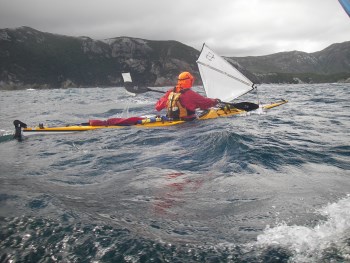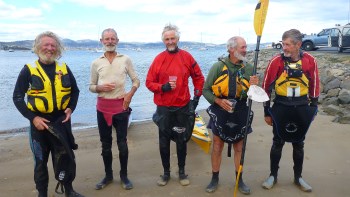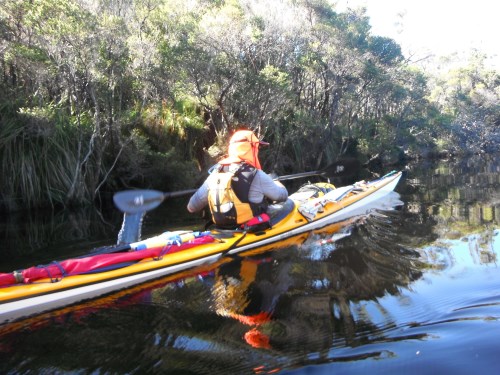A Paipo
Interview with George Bills
April 15, 2013 - Clifton Beach, Tasmania (Australia)
E-mail interview by Bob Green
Additional information was obtained from Diana Gee's To Clifton or
Bust and
Elizabeth Adkins, Maritime Heritage Coordinator
(Department of Economic Development, Tourism and the Arts)
(Click on figures for a larger view where available)
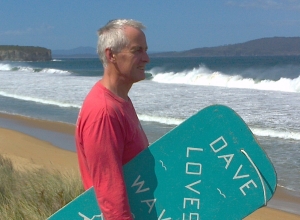 |
Introduction: Surf trips have a long history. In the 1920s, Harvie
Thompson and Cedric Cane searched for spots to fish and
surf. Eventually they settled on Clifton Beach which was accessed
through farmland. George Bills is the grandson of Harvie Thompson. George's
parents also rode the style of board that George continues to ride to this day.
Boards were originally made of solid wood; marine plywood is now the construction material of
choice. Wetsuits were a late addition to this island that faces
the Antarctic. While George rides a variety of surfcraft, bellyboards
allow him to have fun in conditions that keep others out of the water.
Caption: George Billis with bellyboard at his Beloved Clifton Beach
with a fairly large southerly swell. Cape Deslacs to left and Tasman
peninsula to right. Photographed on Saturday, October 5th, 2013. Photo courtesy of George Billis.
|
|
1. What are
your first memories of bellyboards? When was this?
I
am 57. I was first put on a body board at
Clifton Beach in 1960. I remember dad making two new flat marine
plywood
boards for my mum and brother in the early sixties. They are made from
marine plywood. The boards are on display at the Carnegie Gallery in
Hobart, Tasmania, and the two boards on the right in the photograph
below.
George Bill's homemade boards at Clifton Beach.
|
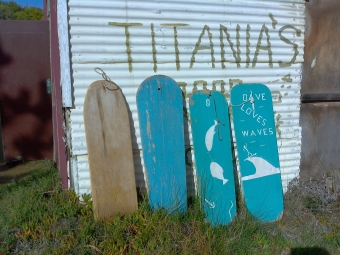 |
|
Left to right:
(1) Harvie Thompson bellyboad, made from a single piece of hoop pine, ca.
1925.
(2) Painted blue over pink, with two nailed battens on the
bottom, this surfboard is believed to have been made in the late-1940s
by Harvie Thompson for his daughter, Sue, for surfing at Clifton Beach.
It is made from a single piece of steam-curved wood.
(3) Nigel Bills
made this board in the early-1960s for his wife, Sue, about twenty years
after they were married. Marine plywood with a rounded nose and rounded
tail, and a hole for a rope. This blue board has two white
fish and the letters S B near the nose.
(4) Nigel Bills board made for his son, David, to surf at Clifton
Beach, ca. early-1960s. This marine plywood belly board has a rounded nose
with rope hole, a
rounded tail and is painted blue with a stick figure surfing
and white lettering, "Dave loves waves."
|
Photo and caption description courtesy of George Bills. |
2. I've referred to these wooden boards as bellyboards. What do you call them?
We have always called them bellyboards. We
just used to say, "Let's go surfing" or "Grab your boards." Yes, they were
called bellyboards but grabbing your surf board would have been more
the language used. These were the major modus operandi in the 1960s, so a
surf board at Clifton was a bellyboard.
Even in summer the water must have been cold. How did
your family stay warm before wetsuits?
The water temperature at Clifton varies from about 13C to 18C (55F to 64F). The first
wetsuit I owned was in 1970, when I was surfing in winter on stand-up
boards. Prior to that we surfed most of the year just in bathers. In
the early-1960s as stand-up surfing took off, football or rugby jumpers
were common. I used these and t-shirts on bellyboards.
3. Have you continuously ridden bellyboards or are they
a surfcraft you rediscovered later in life?
I always return to them when conditions are not
good for longboarding, wave skiing or body surfing. So if there are
close-out conditions and the tide and depth is right for this "stand
and deliver" type of surfing that is what I use in preference to a
boogie board.
Shown below is a board I made about 10 years ago. It is based on a
boogie board I had but I made it longer. Note the cut away for the
thighs. This board really flies and will go further on a wave than a
boogie because of its hard surface and planing ability. It usually has
a rope on it. As mentioned previously when the surf is no good for a
long board or a wave ski this is the weapon of choice, i.e., low tide
shallow water, closed-out waves or even howling onshore.
George Bills plywood bellyboard derived from a boogie board design.
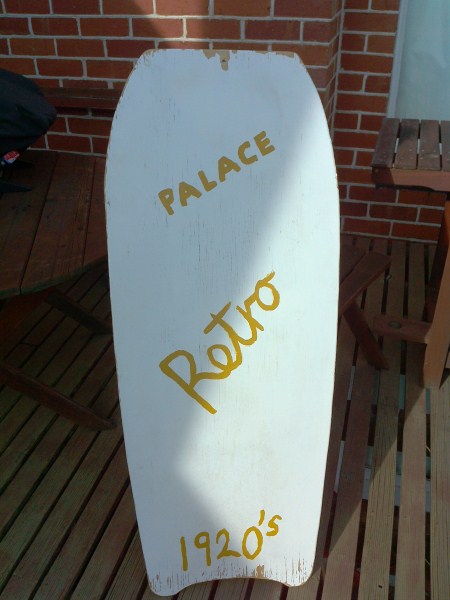
Photo courtesy of George Bills.
4. Both your parents rode bellyboards. What do you know
about your mother's involvement with bellyboards? How and when did she
start bellyboarding, what types of bellyboards did she ride, and for how long did she ride bellyboards?
Mum (Sue) is 87, and she started bellyboarding
about 80 years ago at Clifton Beach. She last surfed about four years
ago.
5. How about your father's background and experience
with bellyboards?
Dad (Nigel) was from Adelaide and met mum
during the war. They were married in 1946, settled in Tasmania and
straight away he was down at Clifton beach using bellyboards or body
surfing until his death 18 years ago.
Is it the case that your mother starting riding
bellyboards before your father?
My mum started surfing on bellyboards in the early-1930s, her sisters
slightly earlier. Dad would have started no sooner than 1946.
6. What is the connection between your family and Harvie
Thompson? What do you know about Harvie Thompson and his surfing?
E.H. (Harvie) Thompson was my grandfather. He was from
Sydney. He was a lawyer/farmer and became second in command to Sir Henry Jones at
IXL. He missed the surf. He and my grandmother, Margery, would camp and
surf at Blackmans Bay but were always on the lookout for and exploring
options for better surf. His exploration ended up with him and his
great friend C.H. (Cedric) Cane finding Clifton and doing a deal with a local
farmer at Clifton Beach (see my aunt's book Clifton or Bust) and
setting up one of only two private estates in Tasmania. Many of the
first people who purchased land were from Sandy Bay and had surf
lifesaving/surfing interests from Sydney.
Harvie Thompson is
believed to have made this surfboard from a table top for his wife,
Margery, ca. 1925. This is one of the first boards surfed at Clifton.
It is a straight, single plank of solid timber with a tapered nose and tail,
and a hole for a rope.
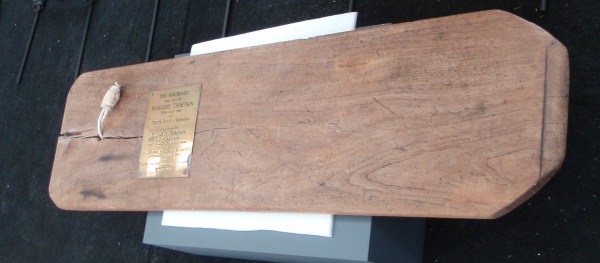
Photo courtesy of George Bills.
When do you think your relatives first rode
bellyboards?
I am the youngest of the cousins. Harvie Thompson had five daughters,
two of whom were most interested in surfing and Clifton. My mother Sue
Thompson (née Bills) had three children and my aunt Diana Gee (née
Thompson) had five. My grandfather's land was divided between my mother
Sue and Aunty Di in the
1960s (Aunty Di is the author of To Clifton or Bust).
My aunt married before the war and had a shack at Low Head on the
Tamar. Her children bellyboarded there starting from around the end of
the war. The family (i.e., children and grandchildren) now has three
shacks there. They use boogie boards when there is surf [see Note 1].
(Below left) Harvie Thompson
and Cedric Cane at Clifton in the late-1920s. (Below right) Thompson on his
cedar board made from a dining room table. Hugh Cane noted other boards
were made from 2 x 4-foot boards from kerosene tin boxes while Sue Bills
recalled pine boards made by Saunders, a Hobart timber merchant.
|
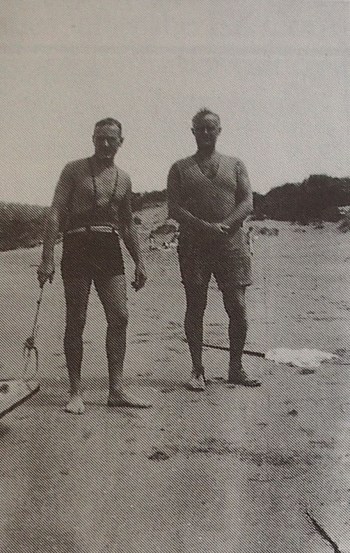
|
|
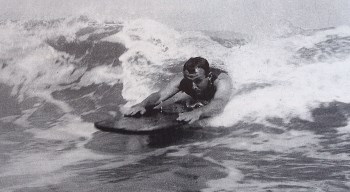
|
Photo source and caption
information: Gee, Diana. 1997. To Clifton or bust: a review of eight decades at Clifton Beach in Tasmania. Sandy Bay, Tas: Diana Gee. (OCLC link to book.)
7. While I'm asking you to step back in time, two
bellyboard manufacturers that I have heard about are Risby from Hobart
and Fotheringham from Launceston—what do you know about the boards that these companies made? [See Note 2.]
Some
families had these at Clifton but not the
Thompsons or subsequently the Gees or Bills (Sue Bills and Diana Gee
were
Thompson girls). We always found the flat boards without the curved
nose more efficient with less friction and they don't nose dive if you
know what you are doing. We always made our own—sometimes from table
tops. Funnily enough the Risby family were acquiantances of my family
and lived quite close to us. My grandfather was on the Hobart Marine
Board and they were into timber, so there was a business and social tie
up.
(Below left) Cedric Cane with board, ca. 1938. (Below right) Alan White's car, one of many that navigated the rough
track to Clifton. The board has an interesting sun design on the deck.
|
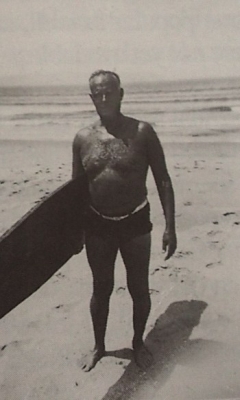
|
|
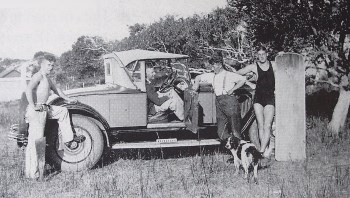
|
Photo source: Gee, Diana. 1997. To Clifton or bust: a review of eight decades at Clifton Beach in Tasmania. Sandy Bay, Tas: Diana Gee.
8. In an e-mail you mentioned a connection with skiing
and Sir Douglas Mawson. Do you have any more details regarding this
part of the story?
There was an intimate connection between the
original five families at Clifton Beach (and their friends), the
Hobart walking club, skiing on Mt. Wellington and the huts at Mount
Field National Park (Twilight Tarn). My mother started skiing at Mt.
Field/Mawson when she was about 12-years-old, when the huts Pandani, Eucalypt,
Fagus and Telopea were down at Lake Fenton (they are still in existence
1 km before Lake Dobson). It was a Sydney thing and has in many cases
carried through to today's generation. My daughter (23) and my son (20)
both ski and surf and enjoy the outdoors in numerous ways. I had a
great aunt who married a doctor from one of Mawson's trips (ship was
the Discovery - our picture of which is at the Antarctic centre south
of Hobart). I first skiied on Mt. Wellington when I was about 7 and my
first trousers were made from the trousers of early expeditioners. As
families, people stayed at the huts at Mt. Field. The non-safety
bindings and some of the old skis were also from this voyage. Mawson
and company used to train at Mt. Field/Mt. Mawson National Park. To a
degree I think Mountains and Surf was a Sydney thing. The early
families at Clifton did tend to be well healed!
9. Do you ride other surfcraft? What do you
particularly like about bellyboards?
I ride a longboard regularly and occasionally
use a wave ski. I do own a boogie board. I still body surf. Sometimes
the conditions just suit bellyboards better. In some ways it is a more
social thing especially with a young family. Bellyboards have
advantages over boogie boards in these sorts of conditions. My wife and
my kids all started with bellyboarding and still go back to it. My wife
uses a boogie board as a bellyboard mainly.
10. What technique is involved in riding these boards?
Do not go too deep otherwise you can't get the forward momentum. The
bellyboards will sink if you lie on them and paddle or use flippers so
you are relying on contact with bottom to get the forward momentum. If
you are too deep all you achieve is jumping up and down.
Start people off just in shallow white water so that they can get their
timing right for their jump. (1... 2... 3... Jump!). You can progress to
unbroken waves later which are faster and more fun and enable you to
use an edge.
After getting your timing right and jumping, land on the board with
your arms out straight and hands holding on to the edge of the board
near the nose. In this position, even on an unbroken wave on a flat
board you will not nose dive (your legs dangling behind-usually from
the mid thigh position will stop this from occuring). Leaning and
turning your trunk enables you to turn the board and slot in on
unbroken waves. If waves are tending to dump you can position yourself
more to the rear of the board.
Because boards are wooden positioning the board on the beach side is
important to avoid collisions and bruising with the board as you make
your way out to the initial position. Normallly a board would be fitted
with a short leash which was used for getting the board out to where
you want to catch waves.
11. The rope on the boards—were they used for hanging
the boards?
The
ropes were used to tow the boards behind you out through the surf. It
was easier to hold onto to board when waves were breaking around you or
on
you. You could duck dive with the board while holding onto the rope if
necessary. We never used the ropes for hanging the boards up.
12. These boards would have first been used without
flippers? I imagine this would have limited what sort of waves could
have been surfed on them? Do you use flippers?
No, but I have tried using flippers with limited succes. At one
stage I rode a boogie board with flippers. Boogie boards are far more
suited to flippers than bellyboards because of their better flotation.
13. Have you seen these type of boards or other
bellyboards ridden elsewhere in Tasmania over the years? Where was
this? Do you still see them being surfed?
I
saw them used at Low Head in northern Tasmania and at Carlton and Park
Beaches in southern Tasmania (apart from Clifton). My cousins still
have properties at Low Head in Northern Tasmania when I was young and
at Carlton Beach in Southern Tasmania.. It is rare to see them in use
now. Most people use boogie boards (because of their softness and
flotation) even when adopting the stand and deliver surfing that was
used most with bellyboards. My sister is 66, and uses a boogie board so
that she doesn't get bruised whereas she used to use a wooden
bellyboard. [Also see Note 3.]
Virginia Stabb, Wilga
Stabb, Judith McDougall and Bob Stabb, with children Struan Stab and
Andrew McDougall, ca. early-1950s.
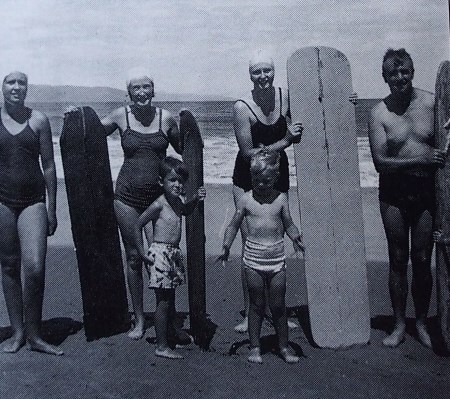
Photo courtesy of George Bills. Photo source: Gee, Diana. 1997. To Clifton or bust: a review of eight decades at Clifton Beach in Tasmania. Sandy Bay, Tas: Diana Gee.
14. When did you start making boards? What is involved
in their construction?
I have only made one as my grandfather and dad
made mine and we have enough in the shed at our shack. I also
concentrate mainly on long boarding. The one I made is the same shape
as a boogie board I had but longer. It is made from marine plywood and
works extremely well. It even has the cut away where your legs go. I
rarely bother with a boogie board and flippers any more.
15. Do you experiment much or stick to a basic design?
What are the dimensions of your boards?
Liz has photos of boards. The old boards are in
at the Carnegie Gallery in Hobart on display and vary in dimensions.
They will be travelling to other parts of Tas. most likely. The most
successful had the largest planing area but the size of the user comes
into this. The bellyboard I made would be 4-foot long and wider than
most.
Old bellyboards boards on display at the Carnegie Gallery in Hobart, Tasmania.
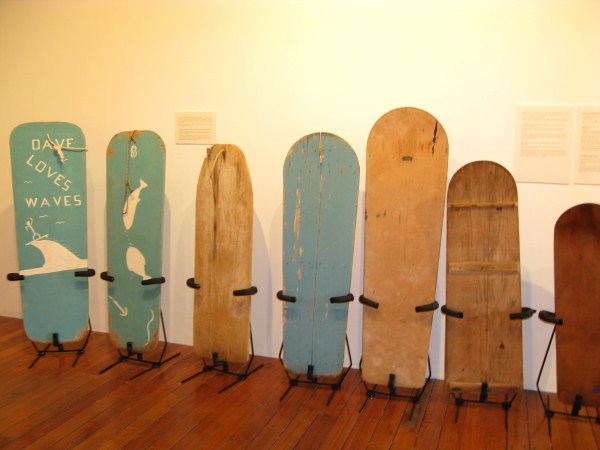
Left to right:
(1) "Dave loves waves,"' made for George's son, David, ca. 1960s.
(2) Nigel Bills ply bellyboard made for his wife, Sue, c. 1960s.
(3) Harvie Bellyboard, hoop pine, made for his daughter Sue. This board
features two nailed battens on the bottom and a steam curved nose, ca.
1925.
(4) Made by Harvie Thompson for his daughter Sue in the late 1940's
(5) Harvie
Bellyboard made of solid timber, ca. 1940.
(6) and (7) are unidentified.
Photo courtesy of George Bills.
16. What sort of conditions are these style of boards
best suited for? Any particular surfs or waves stand out for you from
over the years?
I tend to use them in family situations or when
surf is not suitable for longboards or wave skis such as low tide at
Clifton when you can walk a long way out and still be in only waist deep water.
You can catch unbroken waves and then go on to the white water, whilst
turning on both. Onshore conditions when the sea breeze is up is when I
also commonly use one. You get a much longer ride than on a boogie
board and the boards will plane out in front of the wave and are much
more fun. Low tide conditions are when these boards come into their own
at Clifton.
(Below left) Marion and
Charlotte Smith in the foregorund with their surfing parents. (Below right) Olga
McClean and Wilga Thompson in the early-1920s, "It's the guys who are the
spectators on the beach."
|
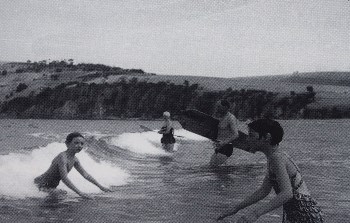
|
|
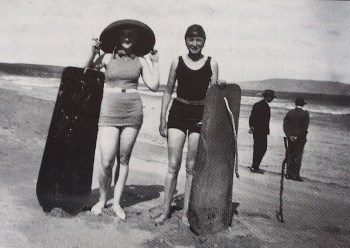
|
Photo source: Gee, Diana. 1997. To Clifton or bust: a review of eight decades at Clifton Beach in Tasmania. Sandy Bay, Tas: Diana Gee.
17. Any other comments?
They do use a different skill set which puts
some people off. You can rotate 360 degrees while going in (my dad was
adept at this). He also used to lie on his back.
Flapping your feet can be useful to get on a wave initially or in
certain situations when on the wave. A paddle stroke with one arm can
also be useful.
My grandmother's board in the Carnegie exhibition dates from 1925.
Although I use one a few times a year it is now rare for other family
members to use them.
They are cheap to make and a novelty. You do get stange looks from
people until they see how well they work in some conditions.
Additional Information
(Below left) Paddling West
Coast (note bent mast a 3m bommie cleaned me up me 5 min before). The
trip took place last March. It is 600km from Macquarie Harbour to
Hobart. We took 27 days. We stopped at Port Davey for 5 days. Landed on
Maatsuyker for 3 days and landed on Dewitt. The whole coastline is
rugged and landings are difficult in big swells especially on the West
Coast. Seven of us did the trip. We carried sails and about 35 kg of
gear and supplies in boats weighing about 30kg. It was a stunning,
challenging and amazing trip
(Below right) Pictured are five of the seven West Coast crew at the end of the
trip. George Bills is in the middle.
Photos and captions courtesy
of George Bills. |
On the Spero River West Coast Trip from Macquarie Harbour to Hobart.
Photos and captions courtesy
of George Bills. |
Notes
Clifton or Bust (short title): Gee, Diana. 1997. To Clifton or bust: a review of eight decades at Clifton Beach in Tasmania. Sandy Bay, Tas: Diana Gee. (OCLC link to book.)
Note 1: On May 23, 2013,
Elizabeth Adkins, Maritime Heritage Coordinator (Department of Economic
Development, Tourism and the Arts) advised,
"As for when these boards
were first used in Tasmania? That's a tricky question to answer for
certain. I think I mentioned a photograph in the Tas Archives &
Heritage Office collection that shows three young men with two approximately
5 to 6 ft. paipo-style boards on a rocky beach in Southern Tasmania. That
photograph is dated to between 1924 and 1927, so about the same time
that the Thompson family were surfing at Clifton.
I've not found a photograph in the newspapers earlier than 1928, which
was a young boy holding a short bellyboard in the surf at Burnie in
the north west. But by 1930 people were surfing on boards from the
north west to the south and photographs of surfboards during the summer
months were quite common as it became very fashionable.
My
best guess is that during the period of about 1910-1920, when "surfing"
is frequently mentioned in Tasmanian newspapers that this was
a combination of surf-bathing, body surfing, a few bellyboards and
general messing about in the water. Tasmanians who went to the mainland
could have surfed when they stayed at beach cottages and brought it
home individually, but the Thompsons and Canes were the first known and
named so far."
Articles identified by Elizabeth Adkins and Bob Green:
- Author
unknown. (1928, February 15). Happy holiday-makers on the beach at Burnie.
Weekly Courier (Tasmania), p. 2. [ A boy holding a belly board in
Burnie].
- Author
unknown. (1930, January 8). Christmas at the beaches: Unseasonable holiday
weather was experienced this year but the surfing was good. Illustrated
Tasmanian Mail, p. 44. [bellyboarding and one boy standing up].
- Author
unknown. (1930, January 15). Summer days and summer ways: how Australians
spend the holidays. Illustrated Tasmanian Mail, p. 8. [Man
aqua-planing (towed behind boat), describes surfing as a "Sydney
Sport."].
- Author
unknown. (1930, January 15). Good surfing. Illustrated Tasmanian Mail,
p. 37. [Surfers with wood boards at Kingston Beach].
- Author
unknown. (1930, February 19). Three happy surfers at East Beach, Low Head.
Weekly Courier (Tasmania), The Courier Pictorial, p. 27. [Two men
arm in arm with a woman, all carrying boards].
- Author
unknown. (1930, March 5). The Joys of Surfing. Weekly Courier
(Tasmania), p. 34. [three women, one holding a belly board and about to catch
a wave with her eyes shut and laughing].
- Author
unknown. (1930, November 12). Miss Gwen FitzGerald, her brother, and
friends enjoying some good waves; Surfers revelling in the creamy foam;
and Waiting for the next breaker. Illustrated Tasmanian Mail, Christmas
Number, pp. 36-37.
- Author
unknown. (1930, November 12). Surfboards and beach pyjamas. Illustrated
Tasmanian Mail, Christmas Number, p. 39.
- Author
unknown. (1930, December 31). How they spend the summer. Illustrated
Tasmanian Mail, p. 29. [Mr. Harvie Thomson's family and surfing at
Clifton Beach].
- Author
unknown. (1931, January 14). A variety of holiday camp scenes at popular
resorts. Illustrated Tasmanian Mail, pp. 34-35. [Mr. Cedric Cane with
boards and friends; and surfing].
(Below left) Mr. Cedric Cane and some young friends going down to the beach with surfboards and boats.
(Below right) Mr. Harvie Thomson's family and surfing at Clifton Beach.
|
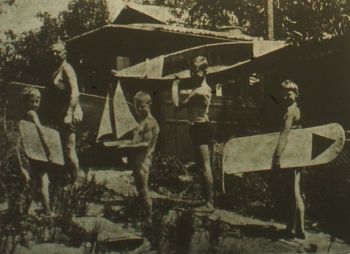
|
|
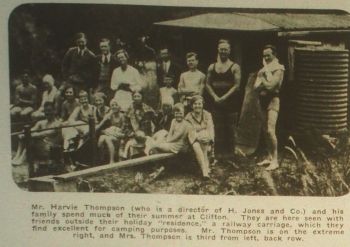
|
(Above left) Author
unknown. (1931, January 14). A variety of holiday camp scenes at popular
resorts. Illustrated Tasmanian Mail, p. 34.
(Above right) Author unknown. (1930, December 31). How they spend the summer. Illustrated Tasmanian Mail, p. 29.
(Below left) Miss Gwen FitzGerald, her brother and friends enjoying some good waves.
(Below right) Surfers with wood boards at Kingston Beach.
|
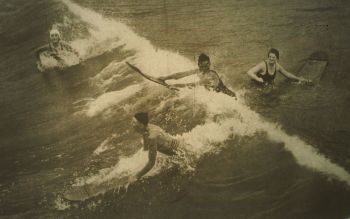
|
|
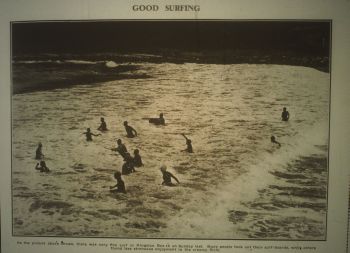
|
(Above left) Author
unknown. (1930, November 12). Miss Gwen FitzGerald, her brother, and
friends enjoying some good waves. Illustrated Tasmanian Mail, Christmas
Number, p. 36.
(Above right) Author
unknown. (1930, January 15). Good surfing. Illustrated Tasmanian Mail,
p. 37.
Note 2: Elizabeth Adkins,
Maritime Heritage Coordinator (Department of Economic Development,
Tourism and the Arts) provided information regarding a J. Fotheringham
& Co., Launceston, Tasmania, bellyboard from the 1930s-1940s, from the Low
Head Pilot Station Museum. The board is described as follows
"Construction: Single plank of Huon pine, with two nailed battens on
bottom, steam curved nose, square tail with hole for a rope. This board
has a small metal maker's badge near the nose on the deck that reads, "J
Fotheringham & Co., 118 Charles St. Launceston, Tasmania." Fotheringham &
Co Sport Store made and sold 'surfing boards' of Huon pine in
Launceston and advertised them in the Examiner from the 1930s to the
1940s. These boards were made from 4 to 6 ft., were painted in a
variety of colours, and would have been enjoyed from Bridport to Burnie
along the North Coast, by men, women and children."
Also see an image of the board here.
Note 3: Limited information
is known about where else these boards may have been ridden in Tasmania.
(Below left) Photo taken
ca. 1948-1950. From the left: Pat Sharp (became a Carmelite nun), Val
Feltham, Mary Allen and Bev Wright. The photo was taken at Dodges
Ferry. Cliff's sister, Bev was about 5'4" so the board is appx 6'.
Cliff's father had an upholstery business and the board was made by one
of his contacts. Cliff's brother, Rex had been to Lorne for an
interstate Commonwealth Bank swimming carnival and seen similar boards.
His was the small board on the left (coloured red and cream). The other
two boards were coloured blue, with a white boarder and black
pinstripe. On each board is the respective owner's name - Bev and Sue.
These boards were used at Park Beach in the 1950s.
(Below right) Mr. Tom and Miss
Gwen FitzGerald and Miss Betty Risby with their surf-boards.
|
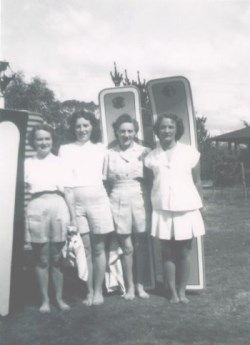
|
|
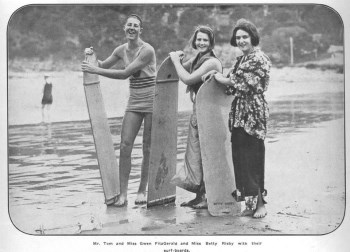
|
Photo
and caption information courtesy of Cliff Wright and the Maritime
Museum of Tasmania exhibition, "Home made: Surfing in Tasmania"
[also see the museum website]. The photo originally appeared in the article, Author
unknown. (1930, November 12). Surfboards and beach pyjamas. Illustrated
Tasmanian Mail, Christmas Number, p. 39.
|
|












